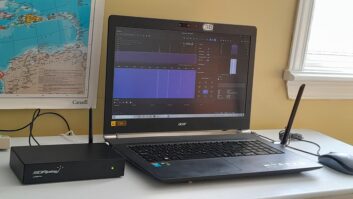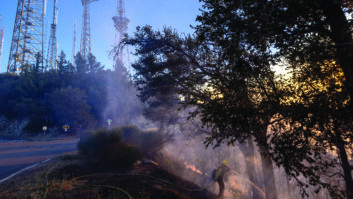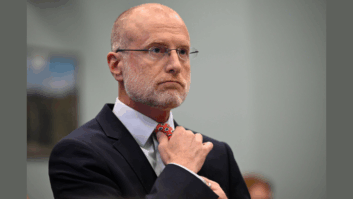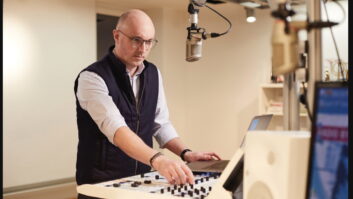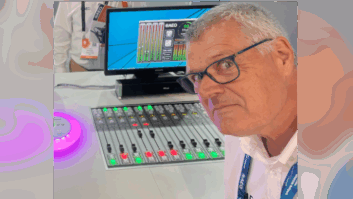Built Right
Jan 1, 2008 12:00 PM, By Chriss Scherer, editor

The WOXL air studio (enlarge)
In general, the planning steps behind any studio relocation project follow a common path. The basic elements of determining the need to relocate, establishing the facility requirements, finding a location and drafting the design plans are always the first steps, and these efforts can be tailored for specific circumstances. For the Saga Communications stations in Asheville, NC, the need to update the facility that had more than 30 years behind it set the steps in motion. While a modern facility was the goal, the Asheville project provided Saga with the opportunity to implement some new technologies and try some new approaches. In the end, a necessary rebuild provided a showcase for the station and the group owner.
Saga owns four stations in Asheville: WISE-AM (sports), WYSE-AM (sports), WTMT-FM (rock) and WOXL-FM (classic hits). The station group was built over the course of several years, and with each station acquisition, the existing studio site was expanded to accommodate.
The old studio was built to house one station: WISE-AM, the heritage AM radio station in the market. Located on the same property as the WISE three-tower array, the site was not in an ideal business location. In addition, being in the middle of an antenna array meant that RF was always a concern with the audio equipment. And while the equipment was kept mostly up-to-date, the building had plenty of wear. As Saga acquired stations, the plan to look for a new studio began. The details finally came together in early 2006 when a suitable studio site was found. The work began to design the facility and begin construction.
The new studio/office site was selected mainly because of its advantageous business location. On the west side of the metro, the facility is in a business area that is easy for listeners to find, which is important for prize pickup and helps strengthen the stations’ ties with the community.
Expand and then build
The chosen building was previously a restaurant. Saga added to three sides of the building to increase the overall floor space from 4,280 square feet to 7,210 square feet. Once expanded, the interior build-out began. This is when one of the first challenges was met: The station lost its full-time engineer.

The news and dubbing studio (enlarge)
To keep the project on schedule, Saga looked to outside help. Greg Urbiel, director of engineering for Saga, contacted Larry Lamoray at Balsys Technology Group to take over the project. This was the first time Saga used an integrator for an installation.
When Balsys came in, the first project modification was made after the studs were in place but just before the drywall was ready to be installed. Lamoray first realized that the conduit entries for each studio’s cables were not in an optimal location and some last-minute relocations avoided what could have been a significant problem.
While the studio space construction was underway, Balsys began building the custom furniture and assembling the studio wiring in its facility near Orlando. The wiring for the technical operations center (TOC) could not be integrated off-site because there were too many factors that would be determined on-site. One of those factors was the final layout of the TOC. With slightly less floor space than originally planned, providing sufficient rack space for the operation could have been a problem. The solution was to go vertical. Middle Atlantic GRK racks were used. Each rack provides 52 rack spaces and stands 8′ tall.
This was going to be a digital facility, and with that in mind, Saga selected Axia for the audio network and Imediatouch for the automation system. With an IP audio system planned for the operation, Ethernet-ready cable was installed for each studio. Again, Saga used an outside service to handle the cabling. The phone system installers wired the office phones and office network, and also ran all the CAT6 cabling for the on-air operation. All the house wiring is CAT6. Each studio has 16 CAT6 drops, two coaxial cable drops, and a stranded #2 ground wire attached to copper bus bars at each end to create the star ground system.
In each studio, Krone blocks and IT-style Ethernet patch bays are used for interconnects. A studio’s audio sources are punched down to one side of a Krone block. The Krone block has RJ-45 connectors on the other side, and an Ethernet jumper runs from the Krone block to an Ethernet patch bay. The CAT6 drop into the studio is connected to the Ethernet patch bay.
While the Axia system can use distributed nodes to provide I/O as needed, the only nodes in the studios are for the microphones. Any other studio audio sources run analog or digital audio back to the TOC via the CAT6 cable. This was done to reduce some costs of installing additional Axia nodes. The Imediatouch computers and Axia engines all live in the TOC, where the signals remain as direct IP runs. The Imediatouch computers use the Axia IP audio driver to attach to the audio network.
Built Right
Jan 1, 2008 12:00 PM, By Chriss Scherer, editor

The production studio (enlarge)
New-found flexibility
Embracing a router-based audio system has provided significant flexibility for the stations. One main advantage is that any source is available to any station, and any studio can be used to feed any station. This provides one level of backup for all the stations. The Imediatouch system has built-in server redundancy in case of a failure, and if part of the Axia system were to fail, the problem could also be routed around. As a final backup plan, each station has a Broadcast Tools switcher to take a feed directly from the automation or any other desired source.
The flexible routing has also allowed Saga to expand the programming of one station. The two AMs run sports formats, and the old studio had insufficient resources to run WYSE on its own, so it simulcast WISE most of the time. With the new studios, there is adequate capability to route sources so that WYSE can often run unique programming. This was particularly useful during the local high school football season.
The new studio layout also takes advantage of the routing flexibility. The large talk studio can now easily be used for either station as it is needed.
Like many facilities now, there are times when an in-studio audio source or feed is needed. For this, Harris World Feed panels are placed in each studio. In addition, a custom Balsys panel housed in a weatherproof box was installed on the front patio to accommodate live broadcasts from the front of the building. Also, each studio has a pop-up data port for power and Internet connectivity.

The WISE air studio is a mirror of WOXL air. (enlarge)
The facility has a 110kVA natural gas generator to power the building if commercial power drops. To supplement that, several UPS battery systems are in place. The on-air operations are powered through a large UPS. In addition, each studio has its own smaller UPS. The various UPS systems provide 1 to 1.5 hours of backup power, which easily covers the generator transfer time, but it also provides some cushion in case there is a generator problem.
The facility’s HVAC system is designed to prevent the typical problem that many studios suffer. Each studio has its own climate control. Air is fed into each studio, depending on the season, this air is conditioned (cooled) or filtered outside air. If heat is needed, the filtered air passes over heating strips in each studio’s duct work so that each studio can maintain its own perfect temperature.
Meeting the challenges
Any project has its share of unexpected challenges, and this one is no different. The west side of the property looks into a bluff. To accommodate the low look angle of the satellite dish, the dish is installed in the southeast corner of the lot. Mounting the dish on the ground and clearing the trees on the bluff would have probably provided minimal clearance, although the dish also faces into the parking lot. If any large vehicle passed in front of a ground-level dish, the satellite signal would be lost. The Balsys solution: raise the dish. It is mounted so the center of the 3.8m dish is 12′ off the ground. The foundation � an inverterted T � is buried 8′ into the ground. Raising the dish improved the clearance over the bluff.
The satellite dish was lifted into place with a crane. To complicate this part of the project, there are power lines running near the satellite dish mount. The crane had to lift the dish over the power lines to put it in place.

The voice tracking/second production studio looks into the WOXL air studio. (enlarge)
The facility installation was completed in April 2007, but it did not go on the air until some RF STL issues were resolved. The studio site does not have a clear line of site to any of the transmitter sites. Saga leased tower space on a mountain-top tower and relays the STL signals to the various transmitter sites from there. A small STL tower was erected at the studio to hold the necessary antennas. Obtaining the necessary zoning clearance for this studio tower was a challenge, but it was finally approved.
WYSE has a variation in its STL path. The WYSE audio is carried to the WOXL transmitter site via an STL where it is injected into the WOXL-FM subcarrier. A subcarrier receiver at the WYSE transmitter receives the audio for retransmission. This eliminated one STL path from the project.
So now that the project is complete, the stations continue to learn the new capabilities of their facility. Chief Engineer Gary Robinson notes that routing changes once considered an obstacle are now simple matters, and the overall installation has gleaned praise from visiting radio engineers. While the goal from the onset was to build a top-notch facility, the directive was to build it right and build it well to provide modern, flexible facilities. By doing this, the result is a showcase that the station staff and owners are proud of.
Equipment List
- Adobe Audition
- Alesis RA300
- APC UPS
- Audio Science ASI5042
- Audion Labs Voxpro
- Avocent LV830-AM
- Axia Element and audio network
- Balsys Technology Group project management, system design, systems integration
- Balsys Wood Arts Furniture, maple wood ends for Axia surfaces
- CBT CBT-2
- Cisco WS Series
- ESE ES185U, LX5112
- Fostex 6301B, RM-2
- Harris World Feed Panel
- Heil PR-40
- Henry Engineering Multiphones
- Imediatouch
- Krone punchblocks
- Linksys hubs
- Middle Atlantic GRK Series, RM-KB-LCD17
- Minuteman UPS
- O.C. White Pro Boom Elite
- Omnimount monitor mounts
- Sony MDR7506
- Tannoy Reveal 6
- Tascam CD01UPRO, CDRW2000, 112MKII
- Telos 2101
More images on next page.
Built Right
Jan 1, 2008 12:00 PM, By Chriss Scherer, editor

The 8” racks in the TOC

Behind the rack showing the cable harness bundle

A crane was used to hoist the satellite dish into place.

Floor plan of the new facility. Click image to enlarge.
